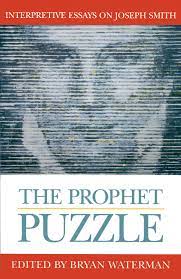Articles/Essays – Volume 33, No. 3
A Prophet, Seer, and Revelator | Bryan Waterman, ed., The Prophet Puzzle: Interpretive Essays on Joseph Smith
What does it mean that Joseph Smith was “a seer, a translator, a prophet” (D&C 21:1)? This is the question addressed by the fifteen essays in this book, the eighth in Signature Books’s Essays on Mormonism series. Over a quarter of a century ago, non-Mormon historian Jan Shipps called upon her colleagues to work towards a solution of “the prophet puzzle”: to reconcile the money-digging young Joseph Smith with the mature prophet and man of God. In the article containing her challenge (reprinted here) Shipps suggested that this gap could be bridged by a greater understanding of what, in Joseph’s case, being a prophet, seer, and translator was all about. The essays printed here represent responses to this challenge.
Mormon readers curious to know whether secular, professional scholar ship on Joseph Smith is at all congruent with contemporary LDS orthodox thought might be surprised at the com plex range of belief they find in this volume. Most of the essays will be familiar to students of Mormon history as all but three have been published before, primarily in Dialogue and the Journal of Mormon History.
Appearing here for the first time are articles by Richard L. Bushman, Eugene England, and Susan Staker. Bushman, who is working on a new biography of Joseph Smith, points in his essay to the centrality of unconventional, unlearned translation in Joseph’s understanding of his prophetic role. (This idea is central in the 1989 essay of Karl C. Sandberg, “Knowing Brother Joseph Again: The Book of Abraham and Joseph Smith as Translator,” reprinted in this volume.) The work of translating the Book of Mormon, Bushman writes, “joined two traditions—the holy calling of seer and the magical practice of divining with a stone.” Joseph Smith’s earlier experience with seerstones “helped [him] move step by step into his calling” (pp. 78-79).
Eugene England’s evocative, literary essay is the single openly devotional piece in the collection. England posits that Joseph Smith’s work and life present a synthesis, and thus a resolution, of the tension between Romantic Utopian optimism and Classical realism. Joseph’s theology of salvation, England writes, “transcended the Classical rationalist extremes of both traditional high church Christianity and Enlightenment secularism and. . .also avoided the Romantic, emotionalistic, and voluntaristic extremes of Calvinism, Revivalism, and Transcendentalist pantheism” (p. 178).
In her finely-crafted article, Susan Staker presents a corrective for the view that Mormon women in Nauvoo were given wide-ranging spiritual authority. The tools of both conventional historical inquiry and textual criticism are combined here in an impressive and important piece of scholarship. Staker’s point of departure is a pas sage from the story of Abraham and Sarai in the Book of Abraham, translated and published by Joseph Smith in 1842 (Abraham 2: 22-25), which she argues is a “narrative about lying for the Lord.” Just as God tells Abraham to lie about his marriage to Sarai, so in Nauvoo marriage became the center of a “culture of secrecy.” Staker concludes that ecclesiastic innovations introduced there did not empower women, but rather, through enforced secrecy, silenced and controlled them “within a hierarchy of male privilege and power” (p. 290).
The strongest essays in the book are made so because they acknowledge the complexity of Joseph Smith and his roles and view the Prophet within his own cultural and historical context. The several contributions which are attempts at psychobiography (and which are unsympathetic to the prophet) are the volume’s weak spots. The argument that Joseph Smith suffered from mental illness or instability is unprovable and, in this con text, reductive.
The introduction by editor Bryan Waterman fronting the collection ad dresses ambiguity in the life of Joseph Smith and draws attention to a number of recent book-length studies that have made significant contributions to the understanding of the prophet and his era, including works by D. Michael Quinn, Nathan O. Hatch, Harold Bloom, and John L. Brooke. While these works are not represented in this volume, their arguments are outlined and discussed by a number of contributors.
Waterman also provides a relevant reading of the portrait of Joseph Smith on the book’s cover, a recent painting by New York artist Lane Twitchell. Here we see Joseph as on an old television screen; he appears familiar and yet obscured by static and bad reception. Waterman’s conclusion is apropos of both Twitchell’s portrait and research on the life of Joseph Smith: though our picture of the Prophet remains filtered by our greater or lesser ability to understand his world, this should not stop us from striving for greater clarity.
The Prophet Puzzle: Interpretive Essays on Joseph Smith, edited by Bryan Water man (Salt Lake City: Signature Books, 1999), 352 pp., $18.95 paper.


 Back to full Issue
Back to full Issue

